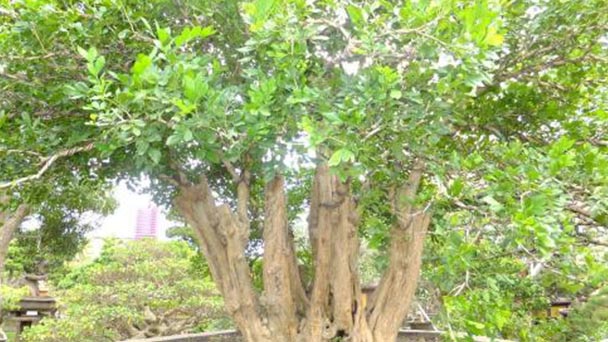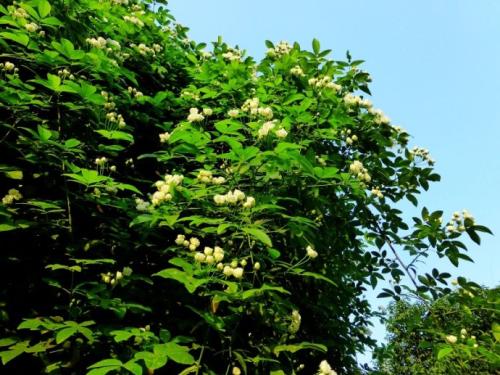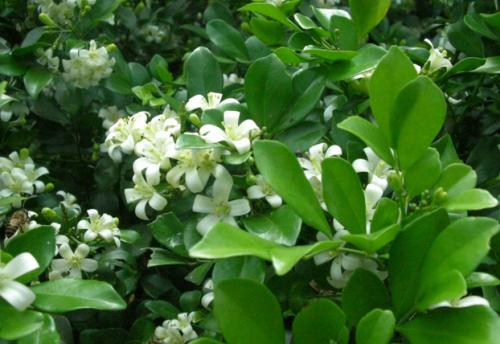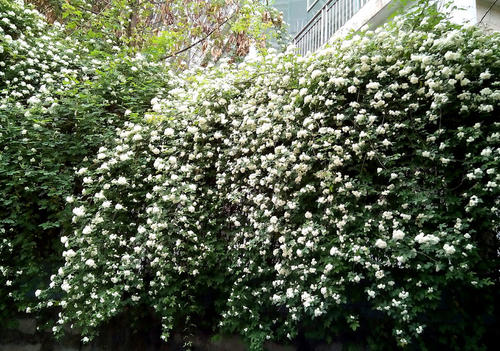Orange jessamine profile
Written by Maggie
Dec 25 2020

Murraya paniculata, also known as Orange jessamine, is a small tree plant., open white flowers, send out a strong sweet smell. It is produced in Guangxi, Guangdong, Fujian, Taiwan, Hainan and Yunnan-Guizhou regions in China. It is born in the thin forest or dense forest of low hills or high altitude mountains. It is more common in limestone regions, granite regions also appear, and sometimes it is a single excellent species within a small area.
Orange Jessamine picture

Morphological characteristics of Orange Jessamine
Orange jessamine is a small tree with a height of 12m. Its trunk and twigs are grayish or yellowish gray with a slight luster. Its original branches are green. The leaves at seedling stage were single, followed by single lobules and two lobules. There were 3~5 lobules and 7 thin lobules in the long leaves. Leaflets are dark green, glossy, ovate or ovate-lanceolate, 3~9cm long, 1.5~4cm wide, apex acuminate, thin short, base short, symmetrical or slanting on both sides, entire, undulating, lateral veins 4~8 on each side; The petiole is less than 1cm long.
Inflorescence axillary and terminal, usually with less than 10 flowers, up to more than 50 rare; Sepals are ovate, 2mm long, margin sparsely hairy, persistent; orange jessamine petals are oblanceolate or elongate elliptic, as long as 2cm, slightly reflexed when holding flowers, scattered light yellow translucent oil points; Orange jessamine has 10 Stamens, alternate long and short, filaments white, linear, slightly shorter than the style, few oil spots in the center and top of the drug septum; The style is green, slender, to 12mm long with ovary, stigma much larger, wider than or equal, ovary 2-chamomile.
Orange jessamine fruit is orange yellow to vermilion, elongate elliptic, thin ovate, apex tapering, 1~2cm long, 5~14mm wide, a lot of dry raised but central dimple-like depression of oil points, seeds 1~2; The seed coat has cotton wool. Flowering period is from April to September, and there are also autumn, winter flowering, fruit from September to December.
Orange Jessamine growing environment
Orange jessamine's most suitable temperature for growth is 20℃~32℃, which is not cold resistant. In winter, when the lowest temperature drops to about 5℃, it should be moved to a 5℃~10℃ room for wintering. If the room temperature is too low, it is easy to drop leaves, affecting the growth in the next year, and it will freeze to death if it is lower than 0℃.
Orange jessamine should be placed in a sunny, airy place where leaves and flowers can flourish. If maintained in the home, when flowering, we can move it on the windowsill, and it still needs to be placed in a sunny enough place. If growing in a half shade place, the fragrance of the flower is weak also, too shade is branch fine and soft, leaf color is shallow, flower is little or without flower, winter room also should be placed in sunshine enough place.
Distribution range of Orange Jessamine
Orange Jessamine is produced in Taiwan, Fujian, Guangdong, Hainan and the southern part of Hunan, Guangxi, Guizhou and Yunnan provinces, as well as in the Philippines, Indonesia and Sri Lanka.

Propagation Method of Orange Jessamine
Sow
Pick plump and ripe vermilion fruits and rub them in clean water. Remove the skins, impurities and gravels floating on the surface of the water and dry them for later use. Spring sowing can be used in both spring and autumn. Spring sowing can be used in 3-5 months. When the temperature is 16℃~22℃, germination takes place 25~35 days after sowing. Autumn sowing is advisable from September to early October. Before sowing, select a nursery with good water and fertilizer conditions.
Dig deep, crush the soil, rake flat to make the check, the check width is 1~1.2m, drill or broadcast. Seeds and fine sand were mixed evenly and scattered on the seedbed. After sowing, the soil was 1.2cm thick. Then, grass was covered and water was poured. When there are 2~3 true leaves, the seedlings should be thinned, the spacing between the plants should be 10~15cm, and combined with weeding, human and animal dung should be applied. After application, water should be sprayed on the leaves to avoid fertilizer burning the seedlings. When the seedling height is 15~20cm, the seedlings should be transplanted.
Cuttings
Cutting is in the spring or rainy season July ~ August. Cut the branch that takes the 1 year above that the organization is full, medium mature, epidermis grey-green makes cut, the tender branch that gives birth to in those days is inappropriate to use. The cuttings were 10~15cm long with 4~5 nodes, and the 1st ~ 2nd internode leaves were cut off to reduce the water evaporation on the leaf surface. In order to expand the hair root surface and water absorption, the cutting mouth required oblique cutting to be smooth, so as to improve the survival rate of cutting. The rooting time was 18℃~25℃, and the rooting time was 35~40 days after the insertion. If the temperature was lower than 18℃, the rooting time would be delayed for 5~7 days.
Treatment with "root sun" rooting agent will be faster. Treatment method: mix 350 times liquid rooting agent and yellow mud into mud, dip sticks and cuttings into mixed slurry, after treatment, insert the mud into the nursery pond when it dries up, and stick sticks into the nursery pond before inserting, so as to prevent yellow mud from separating from the cuttings and affecting the rooting effect.
Cutting medium can be directly used river sand or yellow mud, plant row spacing is 9cmx12cm, after the insertion to use 70%~80% shading network to cover, and then pouring water, spray water 1~2 times a day thereafter, keep the soil in the bed moist, the temperature is 18℃~25℃, 20~25 days after the insertion can be roots.
Layering
Generally, it is carried out in the rainy season, and a part of semi-aged branches is buried in the soil through ring peeling or cutting. After rooting and germination, it can be transplanted after peeling off in late autumn or spring of the following year.
The main value of Orange Jessamine
Medicinal value
1. Cure the muscle damage caused by snake venom
Orange jessamine's inhibitor, phospholipase A, can cure irreversible muscle damage caused by phospholipase in the venom of venomous snakes, potentially leading to new products to improve the outcome of snakebites.
2. Bacteriostasis
Orange jessamine essential oil is mainly composed of -caryophyllene (about 30%) and has a good inhibitory effect on Klebsiella pneumoniae and Bacillus subbacillus.
3. Treat inflammatory diseases
Tramalan and Orange Jessamine were used to treat 100 elderly patients with chronic bronchitis in Guangzhou Medical College.
Clinical application of Orange jessamine
Local anesthesia: The stem and leaf decoction of Orange jessamine has the effect of local anesthesia and surface anesthesia.

Latest Updated
- Benefits of Bugleweed - 7 Science-backed Health Benefits
- Bugleweed Dangers & Side Effects - Is It Poisonous?
- How to Plant Evergreen Trees - What You Should Know
- When to Plant Evergreens - Grow Guide for Evergreen Trees
- 12 Wonderful Evergreen Shrubs for Your Garden
- 12 Popular Evergreen Plants with Pictures for Beginners
- When And How To Prune A Lilac Bush Like a Pro
- How to Grow & Care for Lilac Vine (Hardenbergia Violacea)
- Japanese Lilac Tree (Syringa Reticulata) Care & Propagation Guide
- Shumard Oak Pros and Cons - What to Know
Popular Articles
- Winter maintenance of Antirrhinum Majus
- How to Grow Terminalia Mantaly Tree
- How to Grow and Care for Crossostephium Chinense
- How to grow Antirrhinum Majus in spring
- Peristeria Elata (Dove Orchid) Profile: Info & Care Guide
- Underwatered Snake Plant (Sansevieria Trifasciata) - Signs And How To Fix
- How to Care for Brazilian Jasmine Plant (Mandevilla Sanderi)
- How to Grow & Care for Graptopetalum Purple Delight in Summer
- Rosa Chinensis (China Rose): Plant Growing & Care Tips
- How to Care for Baby Sun Rose (Aptenia Cordifolia)